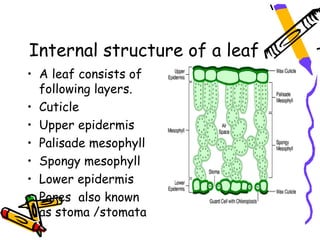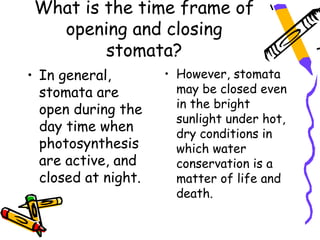Internal structure of a leaf
- 1. Internal structure of a leaf • A leaf consists of following layers. • Cuticle • Upper epidermis • Palisade mesophyll • Spongy mesophyll • Lower epidermis • Pores also known as stoma /stomata
- 2. Cuticle The outer thick waxy covering of the plants and leaves. Cuticle protects plant from drying out by reducing water loss. Does not let oxygen or carbon dioxide pass through it.
- 3. Upper epidermis • Upper epidermis consists of a single layer of cells covered by cuticle. Sometime contains pores which allow gas or water molecule to pass
- 4. Palisade mesophyll • Just beneath the epidermis there are column shaped cells containing chloroplast are known as Palisade mesophyll . • Most
- 5. Spongy mesophyll • The second type of mesophyll tissue is the spongy mesophyll which is composed of closely packed irregular shape cells surronded by air spaces. There are fewer chloroplast because they are under side of the leaf.
- 6. Lower epidermis • Below the spongy mesophyll is the lower epidermis. We will see vascular bundle here and stomata.
- 7. What are stomata or stoma? • The pore like openings in the underside of the leaf leaf is called stoma (singular) and stomata (plural). Each stoma consists of two guard cells which control the opening and closing of the stomata
- 8. What is the function of stoma /stomata ? • Stomata allow carbon dioxide and oxygen and water vapor diffuse into and out of the leaf by opening and closing .
- 9. Structure of stomata • Stomata consists of two guard cells. When there is high water pressure guard cells open. Low water pressure in the guard cells cause stomata to close.
- 10. Do you think stomata are open all the time? • Plants keep their stomata open just enough to allow photosynthesis to take place but not so much that they lose excessive amount of water.
- 11. What would happen if the stomata were kept open all the time? • If the stomata were kept open all the time, water loss due to transpiration would be so great that few plants would be able to take enough water to survive.
- 12. What is the time frame of opening and closing stomata? • In general, • However, stomata stomata are may be closed even open during the in the bright sunlight under hot, day time when dry conditions in photosynthesis which water are active, and conservation is a closed at night. matter of life and death.











